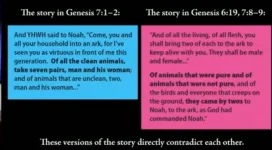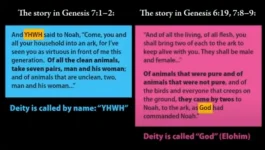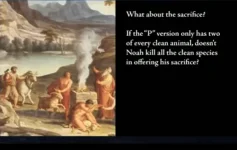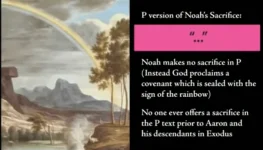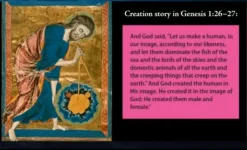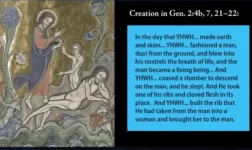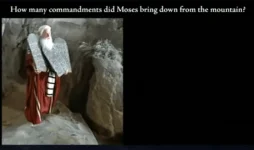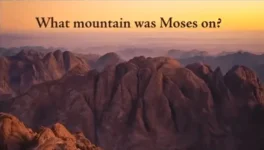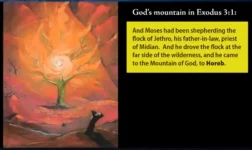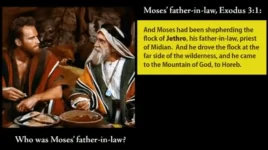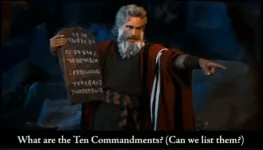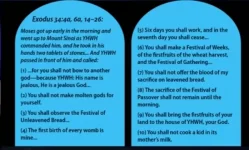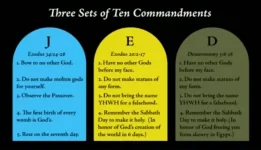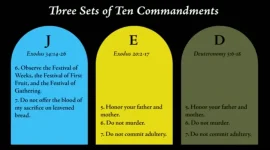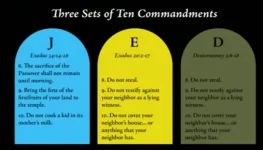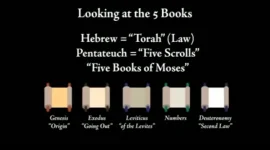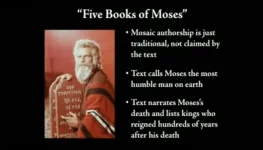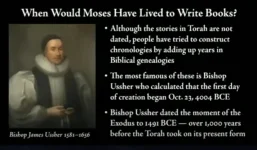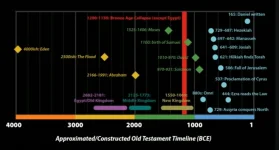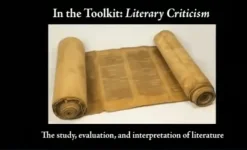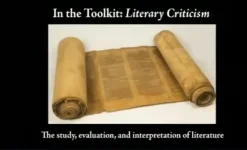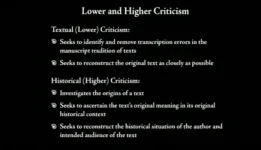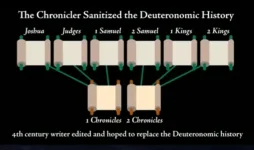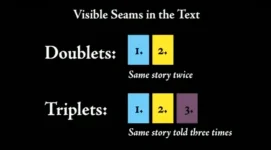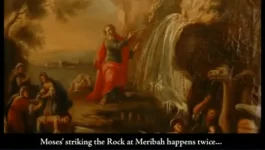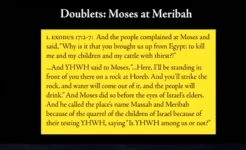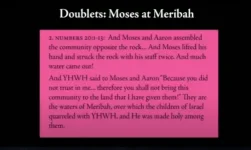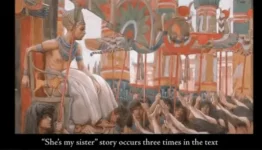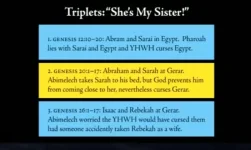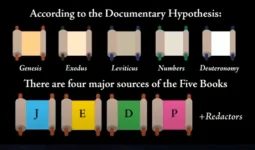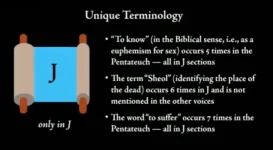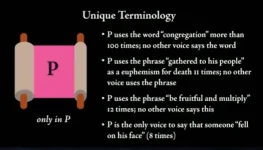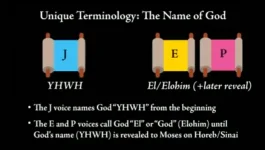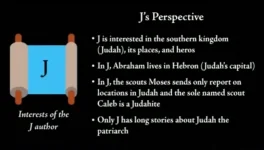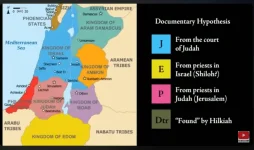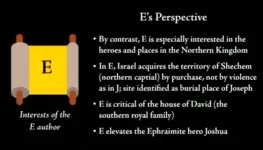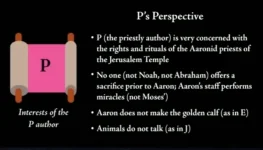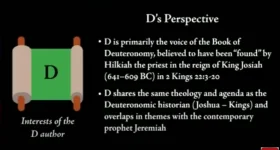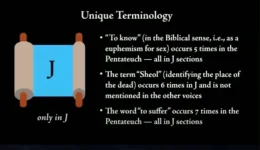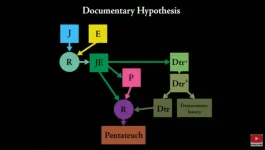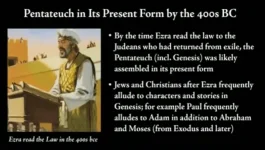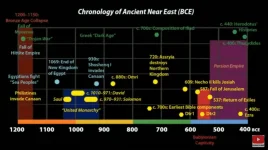Who Wrote the Bible? The Documentary Hypothesis
346,444 views views
Scholars have concluded Moses didn't write the Five Books of Moses. Who did?
The “Documentary Hypothesis” is the most widely accepted explanation of the Bible's authorship among modern scholars. Although Moses was traditionally considered the author of the first five books of the Hebrew Bible (Torah, or Pentateuch,) in this lecture we look at historical, archaeological, mythological, and literary evidence that suggests many different sources were compiled primarily during the Babylonian exile, many centuries after Moses would have lived, if he was a historical figure at all.
Learn more about this topic in these lectures: Who Wrote Genesis • Who Wrote Genesis? Who Built Solomon's Temple?
• Who Wrote Genesis? Who Built Solomon's Temple?  • Who Built Solomon's Temple? The Ten Commandments
• Who Built Solomon's Temple? The Ten Commandments  • What Were the Original Ten Commandments? Paganism in the Bible
• What Were the Original Ten Commandments? Paganism in the Bible  • Paganism in the Bible Before God Was God
• Paganism in the Bible Before God Was God  • Before God Was God Akhenaten and Egyptian Monotheism
• Before God Was God Akhenaten and Egyptian Monotheism  • Akhenaten and Egyptian Monotheism
• Akhenaten and Egyptian Monotheism
346,444 views views
Description
Scholars have concluded Moses didn't write the Five Books of Moses. Who did?
The “Documentary Hypothesis” is the most widely accepted explanation of the Bible's authorship among modern scholars. Although Moses was traditionally considered the author of the first five books of the Hebrew Bible (Torah, or Pentateuch,) in this lecture we look at historical, archaeological, mythological, and literary evidence that suggests many different sources were compiled primarily during the Babylonian exile, many centuries after Moses would have lived, if he was a historical figure at all.
Learn more about this topic in these lectures: Who Wrote Genesis
Summary
- The Bible's classification of clean and unclean animals forms the basis of dietary laws in Judaism, known as kosher laws. These classifications influence contemporary eating habits and religious observance, illustrating the ongoing relevance of ancient texts in modern life.
- Gnostic texts are ancient writings that offer unique insights into early Christian thought and other spiritual traditions. Their discovery sheds light on alternative beliefs that existed alongside orthodox Christianity, highlighting the diversity of religious ideas in the ancient world.
- The first creation story in Genesis 1 presents a cosmic view of God creating the world in six days, whereas the second focuses on a more intimate act where God forms Adam from dust and Eve from Adam's rib, emphasizing distinct theological messages.
- Aaron, as the brother of Moses, is described as the only individual authorized by God to perform sacrifices, highlighting the uniqueness of his priestly role within the religious framework of the Israelites.
- The suggested timelines indicate that there is a significant period between Moses's lifetime and the final compilation of the Torah, which challenges the traditional view of mosaic authorship. This means that while Moses may have contributed to the texts, other authors and historical contexts played crucial roles in shaping the narrative over centuries.
- The interpretations can vary significantly, particularly in the reasons given for observing the Sabbath. For instance, some texts attribute Sabbath observance to God's act of creation, while others link it to the liberation from Egyptian slavery. This reflects deeper theological and cultural nuances in the understanding of the commandments.
- Historical events, particularly the fall of Jerusalem and the Babylonian exile, played a crucial role in the formation of the Torah. It was during the Persian period that records of these texts began to solidify, helping to establish their current format.
- Ezra's reading of the Torah represents a pivotal moment in the formal recognition and transmission of these texts. It marked the first time many people encountered the Torah in a structured way, contributing to its established role in religious and cultural identity.
- Understanding the literary context allows scholars to grasp the intent and meaning behind the texts, helping to differentiate between symbolic representations and historical facts, thus giving a fuller interpretation of the biblical narrative.
- Doublets in the Pentateuch illustrate the presence of multiple perspectives and traditions within the same scriptural accounts, allowing readers to appreciate the complexities of the narratives and the variation in storytelling that evolved over time.
- The Documentary Hypothesis suggests that biblical texts are composed of various sources and voices, providing a framework to analyze how the scripture was edited and compiled over time, revealing theological and historical motives behind the text.
- The different sources provide varied perspectives on key events and characters, revealing complex theological and literary themes. By analyzing the distinct characteristics and terminologies used by each source, scholars can gain insight into the historical context, cultural values, and religious beliefs of the time, enriching the overall interpretation of biblical stories.
- Redactors were editors responsible for combining various sources into a singular text. They played a crucial role in maintaining thematic consistency while allowing for diverse perspectives within the narrative. This process involved merging different stories, characterizations, and theological viewpoints from sources such as J, E, D, and P.
- The J source emphasizes narratives linked to the southern kingdom and its heroes, while the E source focuses on northern heroes and events. This distinction is manifested in contrasting accounts of territorial acquisition and differing attitudes towards historical figures and rituals.
- The Deuteronomist's approach is distinct in that it encapsulates moral teachings and community governance in a standalone text, focusing less on narrative and more on societal obligations, ethical laws, and covenant theology as it relates to the Israelite community.
- The southern kingdom of Judah is portrayed through themes of royal lineage, notable historical figures like Abraham, and the significance of key locations such as Hebron. The texts focus on the nobility's interests and conflicts, often highlighting violence and morality.
- The Priestly source is significant for its detailed focus on rituals, laws, and the Aaronid priesthood, shaping the narrative to reflect the importance of religious practices in society. It often features characters like Moses and Aaron in a collaborative light rather than emphasizing one over the other.
- The exile introduced exiled communities to new cultural and religious ideas, leading to significant theological reflections and the compilation of existing narratives to unify and strengthen the community's identity upon their return.
- Scholars analyze linguistic styles, themes, and theological perspectives in the texts, identifying inconsistencies and overlaps that suggest varied authorship, as exemplified by the distinctions between the Yahwist and Elohist sources.
- Different interpretations can lead to contrasting beliefs about the nature and authority of scripture. While some denominations may emphasize a literal understanding, viewing the Bible as the inerrant Word of God, others may recognize the historical and literary contexts that shaped the texts, offering a more nuanced understanding of scriptural inspiration and authority.
- The evolution from biblical Hebrew to Aramaic was influenced by the geopolitical changes in the region, particularly the conquests by the Babylonians and Persians, which established Aramaic as the administrative and common language of communication.
- The variations in the Noah story depict differing theological views and cosmological understandings in ancient texts, illustrating how writers addressed profound themes such as divine judgment and humanity's relationship with God, influenced by their cultural and historical contexts.
- The division marked a divergence in how scriptures were interpreted, with mainline Christianity valuing scholarship and historical context, while fundamentalism favored literal interpretations, reflecting broader cultural and societal tensions.
- The documentary hypothesis significantly impacts how scholars understand the creation of biblical texts. By suggesting multiple authors and sources, it opens up discussions about the historical and cultural contexts in which these texts were produced, highlighting the complexity of biblical literature and its development over time.
- In Judaism, the name of God is regarded as sacred and is treated with utmost reverence. Pronouncing the divine name is seen as disrespectful because it undermines the holiness attached to it. Instead, substitutes like "Adonai" are used during readings to honor this tradition.
Who Wrote the Bible? The Documentary Hypothesis
Discovery of Gnostic Texts 00:10
"The scrolls that were found in Egypt have an entire library of Gnostic texts that had been entirely lost until they were found in the middle of the 20th century."
- Gnostic texts discovered in the mid-20th century provide profound insights into ancient spiritual and philosophical beliefs.
- These writings were previously unknown and offer a unique perspective on the religious landscape of the time, emphasizing their significance in the study of early Christianity and other theological discussions.
Exploration of the Hebrew Bible 00:17
"Tonight we are talking about the Orthodox Bibles of the Jews; we're looking at the first five books of the Hebrew Bible."
- The discussion shifts to the Orthodox Bibles of Judaism, focusing specifically on the first five books, known as the Torah or Pentateuch.
- These texts, also referred to as the five books of Moses, are foundational to both the Hebrew Bible and the Christian Old Testament, underscoring their importance within these religious traditions.
The Story of Noah's Ark 01:00
"How many of each type of animal was on Noah's Ark? Two, says what Genesis says."
- A key theme presented is the story of Noah's Ark, particularly focusing on the debate surrounding the number of animals that were saved.
- While the common portrayal is of two animals per species, a deeper analysis reveals that the Torah actually mentions seven pairs of clean animals, complicating the simple narrative typically presented.
Clean and Unclean Animals 02:50
"Certain animals are kosher and others not kosher, so like non-kosher animals, you have a more elaborate classification."
- The classification of animals into clean and unclean categories, according to biblical law, plays a vital role in understanding dietary practices within Judaism.
- Characteristics such as cloven hooves and chewing cud define whether an animal is considered clean, illustrating the complex guidelines that influence food choices in religious contexts.
Contradictory Accounts in Genesis 06:28
"In this first it says all of the clean animals only came by twos, while in the other, it's fourteen."
- The video addresses apparent contradictions within the Genesis text, specifically regarding the number of clean versus unclean animals taken onto the Ark.
- This discrepancy suggests the presence of multiple authors in the biblical text, a viewpoint supported by the Documentary Hypothesis which proposes that different narratives reflect diverse theological perspectives.
Significance of Multiple Authorship 09:36
"The new theories still rely on the idea that there's more than one author in the biblical text."
- The significance of recognizing multiple authorship within biblical texts leads to a deeper understanding of the varied interpretations and theological messages interwoven in the scriptures.
- Scholars advocate for the analysis of these contradictions as a means of uncovering the historical and cultural contexts that shaped the narratives we read today.
The Role of Aaron and Sacrifices 10:59
"Aaron is commanded by God to begin doing sacrifices as part of that, and only then Aaron and his descendants are the only people... who were ever allowed to sacrifice."
- Only Aaron, the brother of Moses, and his descendants were authorized by God to perform sacrifices according to biblical accounts. This limitation is significant because it emphasizes the unique role of Aaron's lineage in the religious practices detailed in the scriptures.
- The text notes that this exclusivity excludes other figures like Noah from bringing sacrifices, as they were not sanctioned to do so.
Two Creation Stories in Genesis 11:35
"Indeed there are two separate creation stories at the beginning of Genesis, and they are side by side."
- The Book of Genesis features two distinct creation narratives. The first account, found in Genesis 1:1-2:4, describes God creating the world in six days and resting on the seventh.
- The second creation story, beginning in Genesis 2:4, focuses on the creation of man (Adam) from the dust and the subsequent creation of woman (Eve) from Adam’s rib. This version presents a more anthropomorphic view of God's creative process as He breathes life into Adam and forms Eve from his side.
The Ten Commandments and Their Origins 14:22
"How many commandments did Moses bring down from the mountain? You'd say two tablets... everyone thinks it was Sinai."
- The common belief is that Moses received the Ten Commandments on Mount Sinai, but the biblical text also refers to Horeb as the mountain of God where Moses encountered the divine.
- This discrepancy between the two names may stem from different authors contributing to the text, leading to variations in the narrative.
Moses' Father-in-law: Jethro or Reuel? 16:07
"Now we have that the name is, in fact, not Jethro but Reuel."
- Moses is said to have a father-in-law named Jethro, but earlier texts refer to him as Reuel. This inconsistency indicates potential variations in the storytelling tradition within the biblical texts, which may reflect shifts in focus or authorial intent.
Listing the Ten Commandments 16:50
"Of the Ten Commandments, can we list them all? You can, and I'll see."
- There is confusion surrounding the exact phrasing and order of the Ten Commandments, as they are counted differently by various religious traditions. Despite this, they generally include prohibitions against theft, murder, adultery, and coveting, among other directives.
- A humorous anecdote illustrates that even individuals advocating for the Commandments can struggle to recall all of them, emphasizing both their complexity and cultural significance.
The Nature of God's Covenant 21:00
"This is what God has written on the tablets and this is what God says as he's making a covenant."
- The covenant made between God and the Israelites is foundational in the biblical narrative, marking a significant moment with Moses receiving the specific laws. The commandments serve to define the relationship between God and His people, establishing moral and ritual standards.
The Ten Commandments and Their Interpretations 21:36
"Canaanite paganism involved sacrificing the firstborn child to a particular god, but in the context of the Ten Commandments, this demands redemption rather than human sacrifice."
- The understanding of ancient Canaanite paganism included the practice of sacrificing the firstborn child to a god. However, the implementation of the Ten Commandments fundamentally rejects this practice by advocating for the sacrifice of a ram instead of a human child, emphasizing redemption over human sacrifice.
- The Ten Commandments are not uniform in their presentation; they appear three times in the Torah, leading to variations in their interpretation. For example, in the differing versions, only three or four commandments overlap, while others might focus more on festivals and sacrifices.
- In the different sources identified as J (Jahwist), E (Elohist), and D (Deuteronomist), the Ten Commandments reflect significant differences. The commandments promoting monotheism, prohibitions against making graven images, and proper observance of the Sabbath can vary, particularly regarding the reasons for honoring the Sabbath.
- The E version of the commandments attributes the observance of the Sabbath to God's creation of the world in six days, while the D version links it to God's liberation of the Israelites from slavery in Egypt.
The Five Books of Moses and Their Authorship 25:22
"Mosaic authorship is a traditional belief but is not claimed by the text itself, which narrates events beyond Moses’s death."
- The five books known as the Torah, or Pentateuch, traditionally attributed to Moses, include Genesis, Exodus, Leviticus, Numbers, and Deuteronomy. Each title has a specific meaning derived from Greek or English, reflecting its content.
- Mosaic authorship is accepted as tradition but does not originate from claims made in the texts. According to the textual narrative, Moses is depicted as a humble man, which casts irony on his purported authorship of the text recounting his achievements.
- The text includes accounts beyond Moses's lifetime, suggesting that while he may have penned certain parts, other authors would have contributed to sections narrating events post-Moses, such as his death.
- Historical analysis situates significant events like the creation and the Exodus to periods much earlier than the finalized form of the Torah. Scholars have created timelines suggesting creation occurred around 4004 BCE, with the Exodus estimated at 1491 BCE.
Historical Context and the Timeline of Events 30:03
"There exists a lengthy gap between when Moses lived and when the books were composed, showing the complexity of historical dating."
- The texts in the Torah often intertwine legendary figures and historical events, creating a complicated timeline for understanding the history of the Israelites. The scholarly attempts to correlate these narratives with historical records indicate a long period between Moses's life and the compilation of the texts.
- The destruction of the northern kingdom by Assyrians and subsequent events in the southern kingdom of Judah lend historical credence to biblical narratives, shaping the understanding of ancient Israelite history and its development of monotheism.
- The discovery of a previously unknown Torah by the scribe Hilkiah, suggests that parts of the biblical law may have been lost or forgotten, prompting religious reforms and the eventual establishment of practices that are foundational to Judaism.
Historical Context of the Torah 31:55
"This is where we start to see that the Pentateuch, the Torah that we're discussing, becomes more historical."
- The discussion begins by positioning the Torah, composed of the five books traditionally attributed to Moses, within a historical framework. It highlights that the creation and formalization of these texts occurred after significant historical events, including the fall of Jerusalem and the Babylonian captivity.
- During the Persian period, specifically around 444 BCE, Ezra is mentioned as a pivotal figure who read the Torah aloud to the people, marking a significant moment in its transmission.
The Nature of Oral vs. Written Tradition 31:55
"Imagine that between here and then, let's say Moses, is over a thousand years without it necessarily having been written."
- The video contrasts oral traditions with the emergence of written texts in the context of the Torah. While it is feasible for an oral tradition to persist over a millennium, the Torah's textual format signifies a shift to a written medium.
- This distinction underlines that the texts discussed are not merely products of oral history but are considered to be written compositions that emerged much later than they were traditionally attributed.
Estimating Biblical Chronology 33:40
"People went through and they would do that same thing with judges; it's often 40 years, and so people added it all up."
- The estimation of timelines within the biblical narrative, particularly concerning events like the creation of Eden and the reign of figures like David and Solomon, is addressed. The methodology relies on counting reigns and significant periods mentioned in the scriptures—often represented as 40 years—as a literary device rather than precise historical fact.
- The idea that these timeframes are largely symbolic illustrates the flexibility of interpreting biblical chronology, as opposed to strictly factual.
Transmission and Preservation of the Texts 35:38
"We have versions almost dating to the time period when Ezra is reading it in that kind of finished form."
- The preservation and transmission of the biblical texts are discussed with reference to the Dead Sea Scrolls, which provide crucial insights into how the texts have held up through centuries of manual copying.
- Scholars use textual criticism to trace and reconstruct the original texts, recognizing that while numerous variations exist, a reliable transmission of the core ideas and themes has been maintained.
Literary Criticism and Historical Context 36:09
"They're treating the book critically so that they can understand where it's coming from."
- The academic approach of literary criticism is introduced as a way to deepen understanding of the biblical texts. This involves distinguishing between lower and higher criticism, with lower criticism focusing on textual accuracy and higher criticism delving into historical contexts and authorial intent.
- This critical methodology enables scholars to read the texts in their original contexts rather than through the lens of modern interpretations, revealing the complexities of authorship and redaction throughout history.
The Role of Redactors in Textual Development 38:40
"One of the things that centuries of literary criticism has unearthed is this ancient practice of using what some literary critics call redactors."
- The function of redactors, or editors, in the process of textual transmission is highlighted. As texts were copied, scribes would often annotate or gloss the margins, sometimes incorporating these notes into future versions of the texts.
- This practice demonstrates how the original texts evolved over time, with redaction leading to expansions or edits that reflect the interests and understandings of later scribes.
The Challenges of Analyzing Gospel of John 41:39
"What's much harder to tease out are the signs embedded in the Gospel of John because we don't have other key texts to compare."
- The discussion highlights the difficulty in understanding the Gospel of John due to the absence of comparative texts. This lack makes it challenging to identify and analyze the signs embedded within this gospel.
- The speaker draws a parallel to the situation with the Pentateuch, where similar issues arise regarding the absence of separate texts to provide clarity on redaction and composition.
- The underlying complexity in both cases suggests that without additional texts, the analysis remains a layered interpretation, requiring deeper scrutiny of the existing content to discern its truths.
The Documentary Hypothesis and Historical Texts 43:30
"The chronicler is actually editing and changing Joshua, Judges, Samuel, and Kings to create a much cleaner version."
- The conversation moves to the Documentary Hypothesis, suggesting that even in the absence of certain texts, it is possible to identify distinct voices in the existing scripture.
- An example of this is found in the Deuteronomic History and Chronicles, which indicates that the chronicler sanitized historical accounts to present a more polished version of events.
- This alteration exemplifies how narrative voices can be interwoven, offering a different perspective on shared history while also revealing the motivations behind these changes.
Contradictions and Doublets in the Pentateuch 46:35
"One of the things that we have are doublets and even triplets in the text of the Pentateuch."
- The Pentateuch contains numerous examples of doublets and triplets, where the same story appears multiple times, often presented with variations.
- The speaker cites the instance of Moses striking the rock at Meribah, which is recounted in both Exodus and Numbers, illustrating how different authors recount events differently while maintaining the core story.
- Such repetitions indicate that multiple voices contributed to the text, revealing the layers of tradition and versions of storytelling present in the scriptural accounts.
The Complexity of Biblical Lineage and Relationships 51:51
"According to the story by the yellow author, they are married but also half-siblings."
- The complexities of relationships are highlighted in biblical narratives, particularly with characters like Abraham, Sarah, Isaac, and Rebecca. The text discusses how initially, Abraham and Sarah are depicted as married and brother and sister, which presents a convoluted familial dynamic since they are half-siblings.
- Later in Genesis, the focus shifts to Isaac and Rebecca, who are also in a similar context; however, they are not half-siblings. This suggests a thematic repetition or formulaic storytelling method, where variations of relationships are explored through different characters and situations.
- These accounts introduce readers to the recurring character of Abimelech, the king who interacts with both Abraham and Isaac, signifying a narrative device that emphasizes the relational complexities between the two sets of characters.
Understanding the Documentary Hypothesis 53:01
"According to the documentary hypothesis, there are four major sources of the five books known as J, E, D, and P."
- The documentary hypothesis posits that the first five books of the Torah, known as the Pentateuch, are compiled from four key sources: J (Yahwist), E (Elohist), D (Deuteronomist), and P (Priestly).
- Each source has its distinctive characteristics and narrative style, contributing to the diverse portrayals of events and figures in the text. Specifically, redactors played an integral role in combining these sources into a coherent text, with an early redactor merging J and E, and a later redactor presumably during the time of Ezra.
- These distinctions are essential in analyzing the textual variations concerning the names for the holy mountain, Sinai and Horeb, as different sources attribute these names differently based on their theological perspectives. J and P reference Sinai, while E and D prefer Horeb.
Linguistic Differences Among the Sources 54:24
"The J source consistently uses unique phrases and terms not found in other sources, such as the phrase 'to know in the biblical sense.'"
- Each source within the Pentateuch exhibits unique linguistic tendencies, which aid scholars in identifying the literary voices that drafted portions of the text. For instance, the phrase 'to know in the biblical sense' is exclusive to the J source, demonstrating how particular euphemisms and terminologies help distinguish the narrative contributions of each author.
- Similarly, the concept of Sheol, a realm for the dead, appears predominantly in the J source but is notably absent in others, highlighting the varying theological perspectives concerning death and the afterlife.
- The P source, on the other hand, introduces repeated terminology such as 'congregation' and specific euphemisms for death, solidifying its identity in comparison to J. This repetition ensures that key themes are emphasized within the context of priestly concerns about community and worship.
The Depiction of God in Different Sources 56:24
"In J, God is anthropomorphized, while in P, God is depicted in a more abstract sense."
- The characterization of God varies significantly between the J and P sources, showcasing a rich tapestry of theological perspectives. In the J source, God is often shown with anthropomorphic traits, such as breathing life into Adam or walking in the Garden of Eden, which creates a more personal and relatable deity.
- Conversely, the P source presents God in a more abstract manner, avoiding physical descriptions or actions. For example, while J refers to God as Yahweh, P prefers Elohim, illustrating a shift in how the divine is conceptualized.
- Notably, the revelation of God's name occurs when Moses encounters the burning bush, signifying an important theological turning point that contrasts with the consistent understanding of Yahweh in the J source.
The Significance of the Southern Kingdom and Judah 01:02:27
"The southern kingdom of Judah places its heroes like Abraham in cities like Hebron, enhancing their historical importance."
- The discussion highlights the southern kingdom of Judah and its significance in biblical narratives, associating key figures and locations with its heritage. Notably, Abraham is linked to Hebron, reinforcing Judah's historical importance as it is regarded as an earlier capital.
- The "J" source, also known as the Yahwist source, is emphasized for its focus on Judah, notably referencing heroes such as Caleb and portraying the tribal identity through stories exclusively within this source.
- This source tends to celebrate the southern kingdom's royal lineage, placing priority on themes that would interest the nobility, such as violence and morality, in contrast to the priests' more ritualistic focus.
Contrasts in Narrative Sources: J and E 01:04:23
"The J source, or Yahwist source, primarily highlights the southern kingdom, while the E source, or Elohist source, emphasizes northern narratives and heroes."
- There is a distinction drawn between the "J" source, which emphasizes the southern kingdom, and the "E" source, which focuses on the northern kingdoms and their heroes.
- The E source narrates the acquisition of Shechem through purchase, contrasting the J source's more violent connotation associated with the region's acquisition.
- These differing narratives reflect their authors’ perspectives, with the E source possibly originating from those connected to the northern kingdom, especially in light of its destruction.
The Priestly Perspective and Its Distinct Traits 01:08:01
"The Priestly author is preoccupied with the rites and rituals of the Aaronid priesthood, shaping how they narrate biblical traditions."
- The Priestly source, or "P" source, is characterized by its focus on rituals and laws, often leading to sections of the text that can feel laborious to read through due to their intricate legal particulars.
- In the Priestly narrative, significant figures such as Moses and Aaron are jointly presented, elevating Aaron's role compared to other sources that often diminish his importance.
- This author's view indicates a desire to preserve Aaron's legacy, resulting in a text where Aaron is less demonized and Moses is not singularly elevated above him.
The Deuteronomist's Unique Influence 01:13:05
"D, the Deuteronomist, is represented in a unique text that provides an independent approach to the themes of morality and community governance."
- The Deuteronomist source, known as "D," introduces a distinct perspective within biblical literature, particularly through the book of Deuteronomy. This text encapsulates its moral messages and societal laws as separate from earlier narratives.
- D emphasizes covenant theology and societal obligation, offering a unique lens on the laws and ethical practices that should govern the Israelite community, implying a community-oriented approach to governance.
The Authorial Voices in Deuteronomy 01:13:16
"The Book of Deuteronomy is believed to have been found by Hilkiah the priest during the reign of King Josiah."
- The Book of Deuteronomy is attributed to a different author than the earlier texts, often referred to as "D." This text is associated with theological perspectives and agendas arising from the Deuteronomic historian's contributions.
- The Deuteronomic historian is believed to have combined various biblical texts, creating a cohesive narrative from the books ranging from Joshua to Kings, while intertwining their themes with those of contemporary prophets like Jeremiah.
- The discovery of Deuteronomy by priest Hilkiah during King Josiah's reign suggests significant historical and religious implications, as it was during a period of reform in ancient Judah.
The Documentary Hypothesis Overview 01:15:10
"The idea is that the earliest texts are J and E, where J introduces fables and anthropomorphic descriptions of God."
- The Documentary Hypothesis posits that the Torah was compiled from several distinct sources, primarily J (the Yahwist) and E (the Elohist). J is characterized by its personable portrayal of God and includes narratives filled with courtly intrigue.
- In contrast, E focuses on the northern kingdom and is thought to be written by exiles preserving the heroism of their ancestors after the fall of the northern kingdom.
- The narrative interweaving later involved a redactor who combined these narratives, leading to challenges in distinguishing the original sources due to overlapping themes and ideas.
The Role of Priestly Texts (P) 01:17:30
"The Priestly source, P, overlaps with many of the same stories in the narrative but tells them differently."
- The Priestly source (P) is believed to have emerged as a response to the earlier J and E texts, crafting its narrative with a heavy emphasis on rituals and priestly duties, often differing significantly in its theological perspective.
- P seeks to represent a formal and structured approach to the stories, contrasting with the more narrative-driven J and E sources, leading to a rich but complex compilation of biblical texts.
Post-Exilic Redaction and Compilation 01:18:55
"After the exile, a final redactor brought together J, E, and P to form the Torah as we know it."
- Following the exile in Babylon, a redactor, potentially Ezra, combined the various narrative strands—J, E, and P—into a single cohesive text, reshaping the Torah for a new religious identity.
- The merging of different theological perspectives occurred as the Priestly influence diminished in the face of the need for a unified religious practice in post-exilic Judaism. This period marked a transition to communal gatherings and sacred reading as central elements in Jewish life.
Historical Context of Biblical Texts 01:23:26
"The earliest components of the Bible are composed in the time period immediately following the Bronze Age collapse."
- The study of biblical chronology often relies on traditional narratives that date texts based on modern readings and mathematical estimations. Bishop Ussher's chronology, for instance, attempts to position biblical events within a specific timeline.
- However, when examining historical contexts, texts such as Deuteronomy reveal that their earliest compositions likely occurred significantly later than the traditional estimates, particularly in relation to the events surrounding the Babylonian Exile.
- Following the Bronze Age collapse, the historical narrative shifts to a Northern Kingdom of Israel, where early figures like Omri emerge, as noted in the interactions with neighboring Assyrian texts.
Language Evolution and Composition 01:26:40
"The Hebrew language has undergone significant variations throughout its history, which is reflected in the texts of the Bible."
- The Hebrew language evolved over centuries, affecting the readability and understanding of biblical texts. Early Hebrew texts were written in an older alphabet, which differed from the later Aramaic alphabet now associated with modern Hebrew.
- As populations were influenced by Empires such as Babylon and Persia, Aramaic rose to prominence as the lingua franca, leading to its integration into rabbinic study alongside Hebrew.
- This linguistic shift is significant; later compositions of biblical texts, including the book of Daniel, utilized both Hebrew and Aramaic, illustrating the complex historical and cultural influences at play.
Literary Criticism and the Bible 01:30:40
"Internal contradictions and variations in the biblical text reveal a long history of multiple authors and redaction."
- Evidence of differing versions and intertextuality exists throughout both the Old and New Testaments, supporting the notion that many biblical texts are composite works rather than single-author narratives.
- For example, the book of Job displays clear seams and different textual layers from various time periods, indicating a history of additions and edits over time.
- This complexity prompts diverse interpretations among Christian groups regarding the nature of scripture, with some embracing a literalist approach while others, acknowledging literary criticism, view scripture as a collection of human responses to divine inspiration.
The Division Between Mainline Christianity and Fundamentalism 01:34:13
"At a certain point in the early 20th century, there's a break between mainline Christianity and what became called fundamentalism."
- In the early 20th century, a significant division occurred within Christianity, distinguishing mainline Christianity from the newly emerging fundamentalism.
- Mainline Christianity was largely informed by academic scholarship, engaging with historical and critical methods of biblical interpretation.
- Conversely, fundamentalism arose as a reaction against this scholarly approach, opting for literal readings of scripture that often disregarded the insights provided by scholarly research.
The Language of the Ten Commandments 01:34:48
"Moses holding the tablets... was that an actual language that was on the tablets?"
- A question arises regarding the language inscribed on the tablets held by Moses in depictions of the Ten Commandments.
- It is suggested that the script used in films such as "The Ten Commandments" might actually represent an archaic form of Hebrew rather than Hebrew or Aramaic as known today.
- The ancient Hebrew script was influenced by Phoenician writing and subsequently superseded when Aramaic became prevalent, leading to the adoption of the Aramaic alphabet in Hebrew writing.
Understanding Different Versions of the Noah Story 01:36:25
"There were three different versions of the Noah story... the authors of those."
- The discussions highlight the multiple narrative versions of the Noah story in biblical texts, primarily categorized as the J (Jawist) and P (Priestly) sources.
- The J narrative is described as more earthy and focuses on different aspects, such as God's hand in closing the Ark, while the P narrative adopts a more theological and cosmic perspective, reflecting ancient Middle Eastern cosmology.
- The complexity of these narratives is illustrated by the fact that they are interwoven within the text, creating contradictions such as the usage of a raven versus a dove.
The Psychological Origins of Fundamentalism 01:41:24
"Is the origin of fundamentalism some kind of reaction to uncertainty and relativism?"
- Fundamentalism is characterized as a reactionary movement, emerging in response to modernity and changing interpretations of religious texts rather than merely being a conservative effort to maintain past beliefs.
- The speaker emphasizes that fundamentalists create their own interpretations, often in direct contrast to progressive viewpoints on scripture, indicating a defensive posture against contemporary scholarly insights.
The Name Jehovah and Its Origins 01:42:45
"Jehovah... is not supported by either the Hebrew or the Greek."
- The name "Jehovah" originates from attempts to vocalize the Tetragrammaton (YHWH), the four-letter representation of God's name in Hebrew, which lacks vowels in ancient Semitic scripts.
- Historical interpretations have led to varying pronunciations derived from Greek sources, blending various linguistic traditions in the process.
- The complexities of how "Jehovah" is rendered illustrate the challenges in understanding historical biblical texts and their translations.
The Name of God in Hebrew 01:45:04
"In Hebrew, they don't write vowels; instead, they say 'Adonai' when encountering the name of God."
- In Hebrew texts, vowels are typically not written, which leads to certain challenges and conventions regarding the pronunciation of the name of God. In rabbinic Judaism, it is considered blasphemy to pronounce the divine name, commonly represented as Yahweh.
- When reading scripture, Jews substitute the unpronounceable name with "Adonai," which is the Hebrew word for "Lord." This practice ensures the sanctity of the name is maintained.
- The King James Version of the Bible reflects this adaptation by translating the name Yahweh as "the Lord." This was done to respect the tradition of not vocalizing the divine name directly.
Development of Hebrew Vowel Indications 01:46:28
"In the Middle Ages, Hebrew developed little dots to indicate vowels, which were later used to help pronounce names."
- During the Middle Ages, a system was developed in Hebrew texts to represent vowels using small dots added to the letters. This was crucial for pronunciation and understanding.
- When various scribes came across the name Yahweh, they inserted vowels from the word "Adonai." This historical transition ultimately led to the creation of the term "Jehovah," which emerged from a combination of the Yahweh consonants and the Adonai vowel markings.
- The discussion emphasizes that "Jehovah" is a mispronunciation, reflecting how the original divine name was never meant to be pronounced this way.
The Documentary Hypothesis and Alternate Theories 01:46:31
"The documentary hypothesis suggests multiple authors contributed to the Torah, yet other theories have emerged that modify this consensus."
- The documentary hypothesis posits that the Torah was not authored by a single individual but was instead the result of the contributions of multiple writers. This remains a significant theory in biblical scholarship.
- However, there's been a shift in scholarly consensus regarding this hypothesis. While many scholars still support it, alternative theories such as the fragmentary hypothesis and the supplementary hypothesis have gained traction.
- The fragmentary hypothesis suggests that the texts are composed of countless small fragments assembled together rather than distinct sources being interwoven. On the contrary, the supplementary hypothesis indicates that an original nucleus of a text was expanded upon by various editors over time.
- Each alternative provides a framework for interpreting the complexities and contradictions found within the Torah, underscoring that it is a product of an evolving process rather than the work of a single author.
Last edited:

